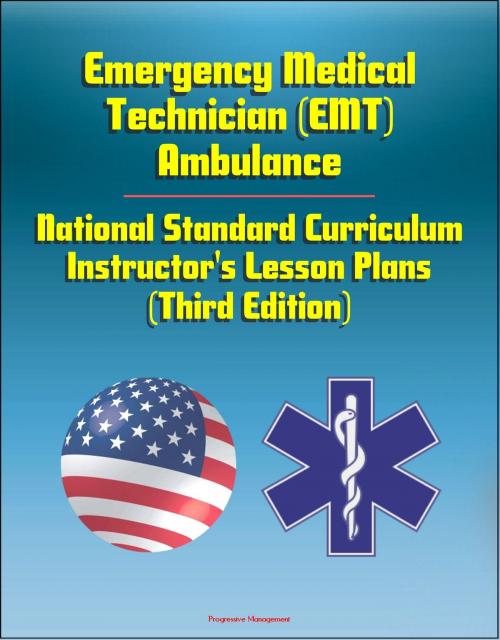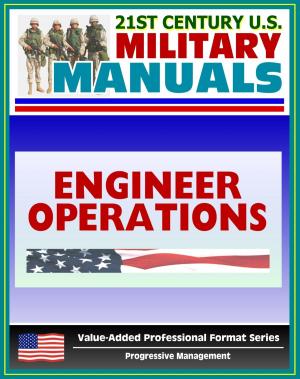Emergency Medical Technician (EMT) Ambulance: National Standard Curriculum Instructor's Lesson Plans (Third Edition)
Nonfiction, Health & Well Being, Medical, Allied Health Services, Emergency Medical Services| Author: | Progressive Management | ISBN: | 9781301766086 |
| Publisher: | Progressive Management | Publication: | September 8, 2012 |
| Imprint: | Smashwords Edition | Language: | English |
| Author: | Progressive Management |
| ISBN: | 9781301766086 |
| Publisher: | Progressive Management |
| Publication: | September 8, 2012 |
| Imprint: | Smashwords Edition |
| Language: | English |
This instructor's lesson plans document is one of three documents prepared for the Emergency Medical Technician—Ambulance, National Standard Curriculum. It was prepared for the course instructors. As such, it contains detailed outlines of course content and guidance for teaching each course lesson. Two other documents complete the training package: a Course Guide which contains planning and management information required by the course coordinator to administer the training program and a Student Study Guide which provides an overview of the objectives and content of each course lesson and includes study suggestions to aid trainees in achieving course objectives.
The training course covers all emergency medical techniques currently considered to be within the responsibilities of the EMT-A providing emergency care with an ambulance service. The course consists of 33 lessons involving 100 hours of classroom and field training plus 10 hours of in-hospital observation and training. The titles and times required for each of the 33 course lessons are given on the following page. The specified training times are minimal; actual training time (including clinical experiences) is expected to range from the recommended minimum of 110 hours to 140 hours or more depending on individual State program requirements. The purpose of the training is to Ensure Individual Competency in Each Student by the successful completion of each objective.
Contents: Lesson 1. Introduction to Emergency Care Training * Lesson 2. Anatomy and Physiology and Patient Assessment * Lesson 3. Airway Obstruction and Respiratory Arrest * Lesson 4. Cardiac Arrest * Lesson 5. Manikin Practice and Certification * Lesson 6. Practical use of Airway Adjuncts * Lesson 7. Bleeding and Shock * Lesson 8. Test and Evaluation-Airway Care, Pulmonary Arrest, Cardiac Arrest, Bleeding and Shock * Lesson 9. Review of Shock and Introduction to the Practical use of Pneumatic Counter Pressure Devices (MAST) * Lesson 10. Soft Tissue Injuries * Lesson 11. Principles of Musculoskeletal Care and Fractures of the Upper Extremity * Lesson 12. Fractures of the Pelvis, Hip and Lower Extremities * Lesson 13. Practical Lab: Fracture care of the Upper and Lower Extremities * Lesson 14. Injuries of the Head, Face, Eye, Neck and Spine * Lesson 15. Practical Lab: Patient Assessment * Lesson 16. Injuries to the Chest, Abdomen and Genitalia * Lesson 17. Practical Lab: Injuries * Lesson 18. Test and Evaluation: Injuries * Lesson 19. Medical Emergencies I * Lesson 20. Medical Emergencies II * Lesson 21. Emergency Childbirth * Lesson 22. Burns and Hazardous Materials * Lesson 23. Environmental Emergencies * Lesson 24. Psychological Aspects of Emergency Care * Lesson 25. Lifting and Moving Patients * Lesson 26. Principles of Extrication * Lesson 27. Practical Lab: Extrication * Lesson 28. Test and Evaluation—Medical Emergencies, Emergency Childbirth, Environmental Emergencies, Lifting and Moving * Lesson 29. Ambulance Operations I * Lesson 30. Ambulance Operations II * Lesson 31. Situational Review * Lesson 32. Final Written Test * Lesson 33. Final Practical Evaluation of Skills * Appendices: Appendix A: American Heart Association CPR Guidelines * Appendix B: Bibliography * Appendix C: In-hospital Clinical Guidelines
This instructor's lesson plans document is one of three documents prepared for the Emergency Medical Technician—Ambulance, National Standard Curriculum. It was prepared for the course instructors. As such, it contains detailed outlines of course content and guidance for teaching each course lesson. Two other documents complete the training package: a Course Guide which contains planning and management information required by the course coordinator to administer the training program and a Student Study Guide which provides an overview of the objectives and content of each course lesson and includes study suggestions to aid trainees in achieving course objectives.
The training course covers all emergency medical techniques currently considered to be within the responsibilities of the EMT-A providing emergency care with an ambulance service. The course consists of 33 lessons involving 100 hours of classroom and field training plus 10 hours of in-hospital observation and training. The titles and times required for each of the 33 course lessons are given on the following page. The specified training times are minimal; actual training time (including clinical experiences) is expected to range from the recommended minimum of 110 hours to 140 hours or more depending on individual State program requirements. The purpose of the training is to Ensure Individual Competency in Each Student by the successful completion of each objective.
Contents: Lesson 1. Introduction to Emergency Care Training * Lesson 2. Anatomy and Physiology and Patient Assessment * Lesson 3. Airway Obstruction and Respiratory Arrest * Lesson 4. Cardiac Arrest * Lesson 5. Manikin Practice and Certification * Lesson 6. Practical use of Airway Adjuncts * Lesson 7. Bleeding and Shock * Lesson 8. Test and Evaluation-Airway Care, Pulmonary Arrest, Cardiac Arrest, Bleeding and Shock * Lesson 9. Review of Shock and Introduction to the Practical use of Pneumatic Counter Pressure Devices (MAST) * Lesson 10. Soft Tissue Injuries * Lesson 11. Principles of Musculoskeletal Care and Fractures of the Upper Extremity * Lesson 12. Fractures of the Pelvis, Hip and Lower Extremities * Lesson 13. Practical Lab: Fracture care of the Upper and Lower Extremities * Lesson 14. Injuries of the Head, Face, Eye, Neck and Spine * Lesson 15. Practical Lab: Patient Assessment * Lesson 16. Injuries to the Chest, Abdomen and Genitalia * Lesson 17. Practical Lab: Injuries * Lesson 18. Test and Evaluation: Injuries * Lesson 19. Medical Emergencies I * Lesson 20. Medical Emergencies II * Lesson 21. Emergency Childbirth * Lesson 22. Burns and Hazardous Materials * Lesson 23. Environmental Emergencies * Lesson 24. Psychological Aspects of Emergency Care * Lesson 25. Lifting and Moving Patients * Lesson 26. Principles of Extrication * Lesson 27. Practical Lab: Extrication * Lesson 28. Test and Evaluation—Medical Emergencies, Emergency Childbirth, Environmental Emergencies, Lifting and Moving * Lesson 29. Ambulance Operations I * Lesson 30. Ambulance Operations II * Lesson 31. Situational Review * Lesson 32. Final Written Test * Lesson 33. Final Practical Evaluation of Skills * Appendices: Appendix A: American Heart Association CPR Guidelines * Appendix B: Bibliography * Appendix C: In-hospital Clinical Guidelines















